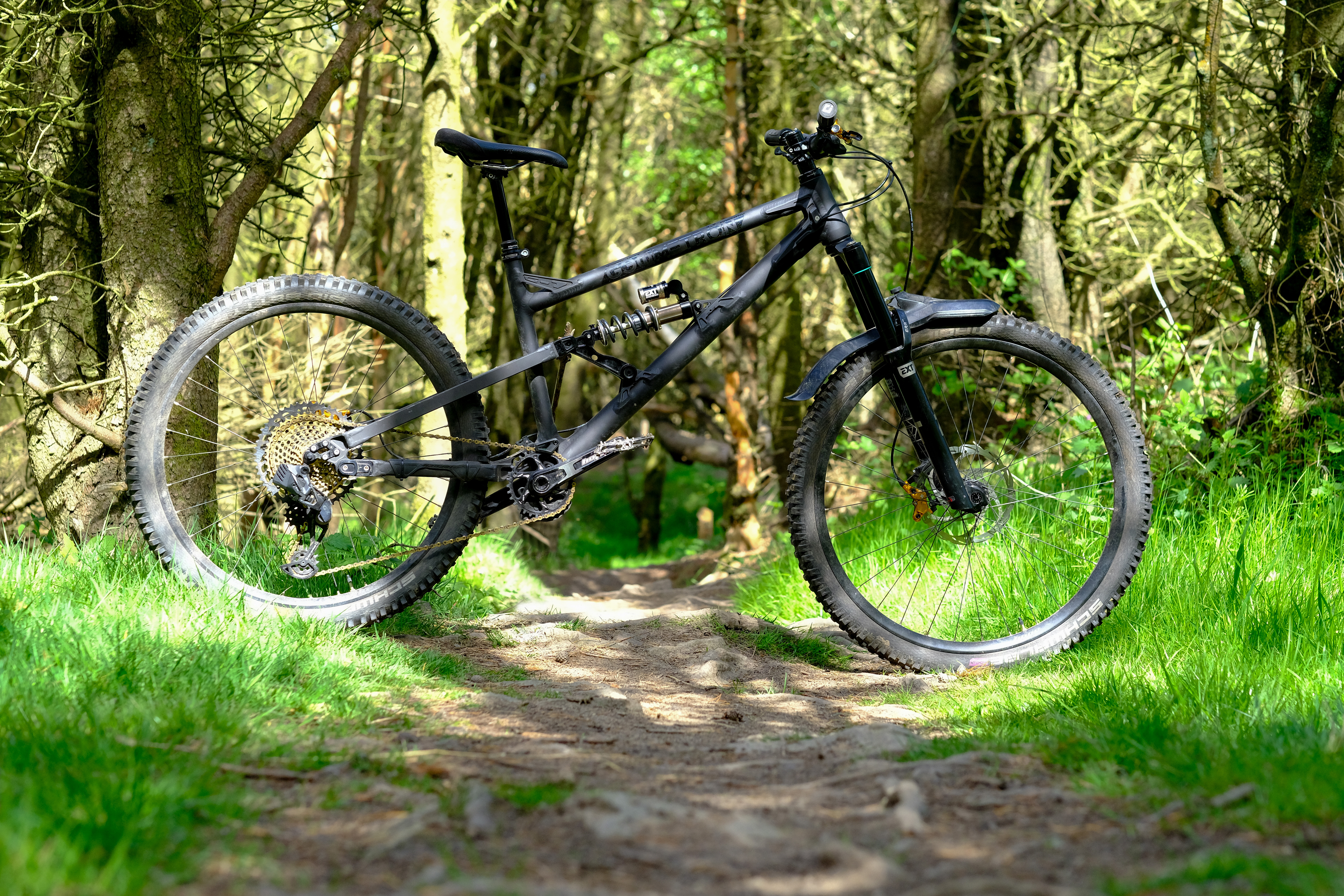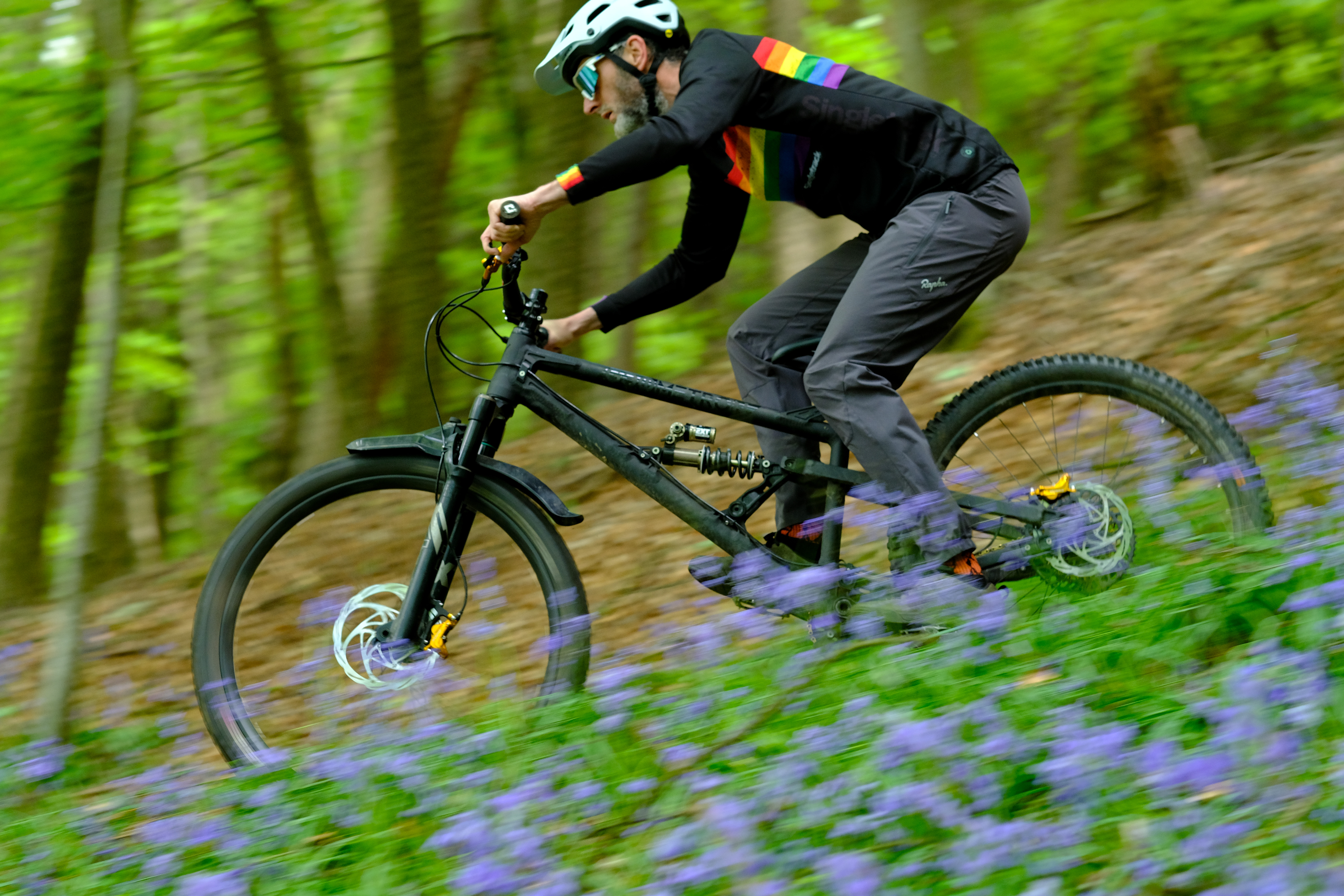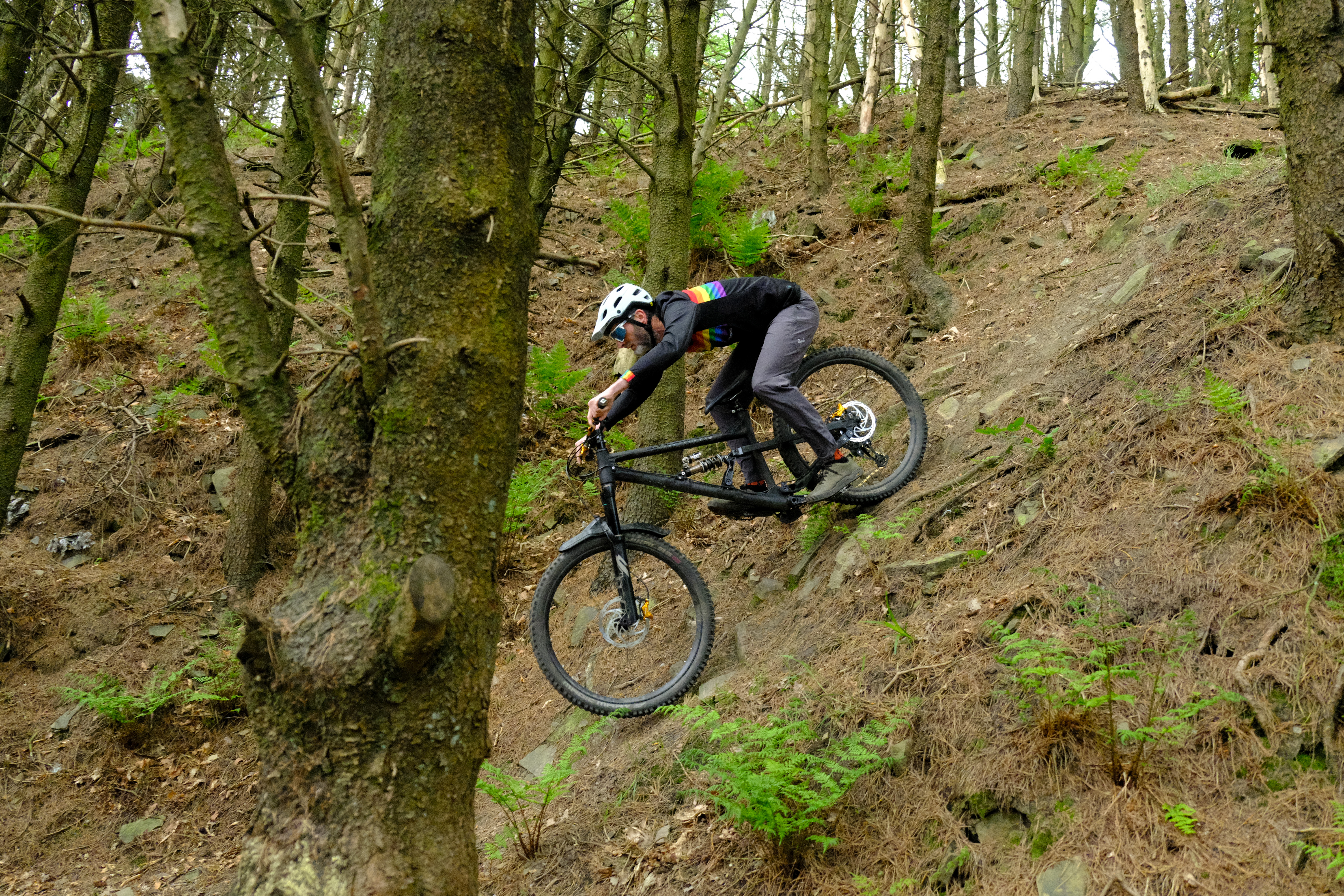GeoMetron is essentially Chris Porter. If you don’t know who Chris Porter is, do a Google. Just make sure you have a brew ready before you dive in.
- Price: £6,700.00
- From: geometronbikes.co.uk
- Tested by: Benji

Essentially Porter is a suspension wizard who got so naffed off with mountain bikes having inappropriate geometry that he decided to make his own. He called his bike brand GeoMetron. He designs the frames; Nicolai manufactures them. That’s why there’s a big ‘N’ emblazoned on the head tube of this and the other GeoMetron models. Speaking of other GeoMetrons, there is no longer any mention of G13, G15 or G16 bikes. They’ve gone all-in on the G1. The G1, however, is something of a shapeshifter. More on this later.
So what was/is so wrong with mainstream mountain bike geometry? In Porter’s refreshingly and unashamedly Preacher Man world view, mountain bikes were too short. They had insufficient reach. They had insufficient wheelbases. They had head angles that were nowhere near slack enough. The GeoMetron G1 can be accused of none of these.
How do you say ‘GeoMetron’? The brand itself is coy about it, but there’s no way a brand fundamentally based on geometry is pronounced ‘gee-oh-met-tron’ is there? ‘Jom-atron’ all the way.
The Bike




Nicolai also makes a Nicolai G1 by the way. The launch of the G1 was executed by both brands back in 2019. There are some minor aesthetic and finishing touches that differentiate the Nicolai G1 from the GeoMetron G1, but it’s the exclusive use of EXT suspension dampers that is key. When you’re talking about a GeoMetron G1, you’re talking about EXT. Especially the EXT Storia V3 coil sprung rear shock.
Apropos of not a lot, this brand pairing reminds me of the partnership of Foes and Curnutt shocks back in the day. Just like you couldn’t really live with yourself if you got a Foes and didn’t get a Curnutt shock, it just feels wrong to get a G1 that doesn’t have a Storia. The Storia shock features a coil spring for the negative spring too, a top out pad and hydraulic bottom out control. An easily missed aspect of the Storia is that it’s mounted on spherical eyelet bearings. Think ball and socket. This reduces shock binding; the shock is freer to compress/extend irrespective of any lateral load forces going through the frame chassis at any time.
Regardless of what brand shock you want to go for, there is definitely a case for going with a coil shock instead of air due to the G1 having a relatively low leverage ratio at the start of the travel (coil shocks don’t need as much force to get them moving initially).
The G1 is a 162mm or 175mm travel enduro bike (travel is altered by a flip chip at the rearward shock mount). It uses a standard Horst-link design with the shock positioned horizontally (attached relatively far and high up the downtube). I tested the bike almost exclusively in the 162mm setting, mainly because the longer travel setting ramps up so progressively that little ol’ me struggled to get at that extra travel in regular trail riding.
A related aspect was also the choice of frame size to test. I went with a Large size, as opposed to an Extra Large. As ever, it was a question of priorities and riding preferences. The extra high-speed stability of the Extra Large would rarely be accessed by me so I went with the increased standover and low-mid speed manoeuvrability of the Large.
It’s worth pointing out that the G1 is adaptable. Via a whole system of ‘Mutators’ you can convert the bike to a full 29in wheel bike, as well as alter chainstay length, bottom bracket height, seat angle and head angle. This is a very reassuring aspect on such an expensive investment. You can be pretty sure your G1 won’t be outdated in five years. Or possibly even ten. Chris Porter’s Mondraker Dune from around ten years ago looks remarkably like the trail bikes we’re all riding around on today.
The GeoMetron G1 is made out of aluminium in Germany. And you either like the way it looks, or you love it. Personally, I’m not an all-out lover of the Teutonic alloy aesthetic but it is impossible to behold this bike and not be impressed by how well it is put together.
I’m not going to go too much into the build kit spec of the G1. GeoMetrons are almost always fairly bespoke. Neither am I going to go into too much about the G1’s geometry. Why? Because it may prejudice certain readers’ thoughts before I’ve even got to the important thing: how the G1 rides.
(Spoiler: you can read the spec and geometry details at the end of this review.)
It’s at this point where I try to sneak in the fact that it doesn’t have bottle bosses. Before riding a G1, I would genuinely have ruled out owning one because of this. After having ridden a G1… where did I put my CamelBak?
The Ride

Can I just write “best mountain bike I’ve ever ridden” and go home?
No?
Dang.
In many ways my verdict is both totally inevitable and wholly resented. I would love to be the child who points out that the Emperor has no clothes on. But I can’t. The Emperor is fully dressed and dressed exceptionally well. Yes, despite his Crocs (sorry, Mr Porter!)
Now, I’m not the first tragic bike journo fanboy to bang on about GeoMetron bikes. But I would like to be one of the few (first?) bike reviewers to compliment the G1 on how nice it is as a cross-country trail bike.
Sure, it will come as no surprise to anyone to hear that the G1 totally rules on descents. That’s kind of all you ever hear about them. You may even hear about how efficient it is on winching up steep fire road climbs (before sending it down the aforementioned descent). What you may not be aware of is that the G1 is really fun and just plain pleasant(!) to pedal around much more sedate terrain. It’s roomy. It’s supremely well balanced regarding bum-saddle pressure and hands-grips pressure.
And that Storia suspension? Genuinely freaking amazing. Cross-country firm under power. Supportive when cornering or ‘working’ the terrain, pumping free speed out of anything and everything. The G1 almost single-handedly makes the case that bike weight and amount of suspension travel are not mutually exclusive to efficient trail manners.
I’d quite ‘happily’ pilot the G1 around some sort of godawful cross-country marathon event around endless Welsh fire roads. It’s the comfiest and nicest mountain bike I’ve ever experienced.
The G1 gets so much macho blathering about how ‘capable’ and ‘aggressive’ it is, I’d just like to put my hand up and say it’s actually a really ‘friendly’ bike.
Not only is it friendly in a riding companion sense, it’s also as friendly as it gets in the workshop. It’s all external cabling (apart from the dropper routing up the seat tube), normal standards and decent sized bolt heads. There are steel inserts in threaded things. The pivot bearings are very well protected with secondary seals.
And when the terrain does eventually narrow and tip downwards? Fuggedaboutit.
To resort to vainglorious, humble-bragging anecdotes, on the first – the very first – ride on the GeoMetron G1, I finally rode something that I’d been eyeing up (and chickening out of) for years. JFDI. The G1 didn’t make me do it in a bullying or foolhardy way, it just felt like it would be okay. It was like that bit in The Matrix where Keanu realises he suddenly knows Kung Fu.
I’m honest enough to realise that I’d struggle to weight the front wheel properly if I’d opted to test an Extra Large G1. The Large here has a reach figure of 515mm, so is hardly short. If you’re a full-on speed charger who spends their rides with their chin in front of the stem faceplate, try a bigger one. I think there’s a lot to be said for being realistic and going with what the GeoMetron sizing chart recommends.
(Psst… On the larger size G1s I reckon you can bodge some sort of water bottle holder in the front triangle with a bit of cunning.)
The suspension design must get as much credit as the geometry for how much of an excellent all-rounder the G1 is. The anti-squat (just over 100% at sag) and the 30% progression in leverage ratio work really, really well with the Storia coil rear shock. The spherical eyelet bearings are definitely at play (pun intended) when the bike hits rough stuff at decent velocity. There’s noticeably less jarring or unpredictable bucking.
For what it’s worth, I didn’t visit GeoMetron HQ in person to do the whole ‘test ride and set-up masterclass’ thing. The G1 arrived at Singletrack HQ in a box and I dialled in the suspension settings that were recommended to me via email. I did try tweaking the settings a bit. Mainly out of professional courtesy/curiosity. I returned to the recommended settings pretty quickly.
Overall

The GeoMetron G1 is the best mountain bike I’ve ever ridden. It will never win a cross-country race but, then again, neither will I. Nor do I want to. Cross-country races are (still) won by those who can climb the fastest. That’s not what I’m about. I want to ride a bike around everywhere and anywhere and never feel ill-equipped or ill at ease.
Any niggles? It’s expensive. But, for once, it feels like the expense is understandable. For the most part. I’m also not sure the EXT fork is any better than other forks costing half as much (which are still flipping expensive). On the whole though, the G1 offers a ride experience that I don’t think is currently available anywhere else.
The G1 is fun, efficient, comfortable, exciting, relaxing, grippy, nimble, planted, capable, reassuring, predictable and pretty much amazing. And most significantly, unique. Mainstream mountain bikes are going to be sooo good in 2032. You’re essentially paying for a time machine here.
Geometron G1 Specification
- Frame // Aluminium, 162mm
- Shock // EXT Storia V3, 230x65mm
- Fork // EXT Era, 160mm, 44mm offset
- Wheels // Hope Pro 40 Fortus
- Front Tyre // Schwalbe Magic Mary, 29 x 2.4in Super Gravity Ultra Soft
- Rear Tyre // Schwalbe Big Betty, 29 x 2.4in Super Gravity Soft
- Chainset // Hope Evo, 170mm, 32T
- Drivetrain // SRAM AXS GX
- Brakes // Formula Cura 4, 203mm/180mm
- Stem // Hope AM 35mm
- Bars // Renthal Fatbar 35
- Grips // ODI Elite Pro
- Seatpost // BikeYoke Revive 213mm
- Saddle // WTB Volt
- BB // Hope
- Size Tested // Large
- Sizes Available // S, M, L, XL, XXL
- Weight // 16.55kg
Geometry For Our Size L Test Bike
- Head angle // 62.5°
- Effective seat angle // 78.75°
- Seat tube length // 455mm
- Head tube length // 130mm
- Chainstay // 453mm
- Wheelbase // 1,324mm
- Effective top tube // 642mm
- BB height // 330mm
- Reach // 515mm





